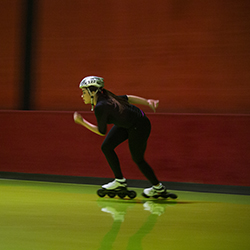Today, Rushen is a competitive speed skater. “There’s nothing like skating 25 miles an hour with the wind in your face. You get such an adrenaline rush,” she says. “I like to be pushed, I like to learn new techniques and get faster.”
Rushen competed in last summer’s national championship in Lincoln, Nebraska, placing fourth out of about 20 women in her age group. But she isn’t satisfied. Yet.
“I got shoved during a sprint on a corner, so I flipped and slid. I get angry about that, because I know I should have placed higher,” she says. “I’m going back and training to do better. My goal is first place.”
Tools that keep her competitive:
1. Skates
Rushen’s carbon fiber skates are molded to her feet like a second layer of skin. She wears her four-year-old skates so tight her feet go numb. That way, her ankles won’t shake when she races. Priced at $1,200, the skates’ boots are low-cut and offer little ankle support, enabling Rushen to lean heavily on her turns around the rink. As for brakes, there are none.
2. Clothing
During practice, Rushen wears Spandex workout clothes. They’re comfortable. They breathe and they’re aerodynamic. What she refuses to wear? Elbow and knee pads. “You don’t want anything slowing you down,” she says. “Everything is about your time.
A good coach will teach you how to fall.”
3. Helmet
Rushen wears a generic bike helmet — and it’s protected her head too many times to count. “Once I was trying to tie my skates while skating and I ran into my coach head first. Another time, I ran into the wall head first because I didn’t realize how fast I was going,” she says. Her advice: “If you are on any kind of wheels, wear your helmet.”
4. Wheels
Rushen owns four sets of wheels, each used for different surfaces. Prices average $200 for a set. Indoor wheels are usually the hardest, outdoor wheels the softest. Speed skaters tend to prefer taller, narrower wheels because they’re more responsive and offer less rolling resistance.
5. Stopwatch
“When I first started skating, the only competition I had was the clock,” Rushen says. “I like the clock better than other skaters because I’m racing against myself. My coach reads the time of every lap I do. It’s essential to training.”
--
This story originally appeared in the spring 2015 issue of Willamette magazine.


